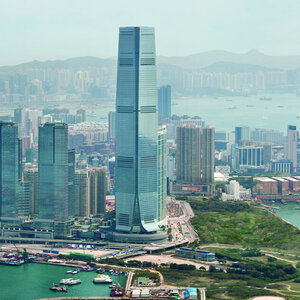The WPJ
THE WORLD PROPERTY JOURNALReal Estate Facts Not Fiction
Commercial Real Estate News

Investment in Asia Pacific Commercial Real Estate to Rise in 2019
Commercial News » Beijing Edition | By Michael Gerrity | January 15, 2019 9:00 AM ET
Global commercial real estate consultant JLL is reporting this week that Asia Pacific's overall real estate transaction volumes in 2019 are expected to rise by five per cent, though the pace of growth momentum will slow down.
"A decade into the economic cycle, investors are contending with macro risks and geopolitical uncertainty such as rising interest rates, continued trade tensions between the U.S. and China, as well as strains in the EU caused by Brexit negotiations," says Mr. Stuart Crow, Head of Capital Markets, JLL Asia Pacific.
"Against this backdrop, real estate continues to look attractive as a safe haven for investments, with its portfolio diversification benefits and relatively higher returns compared to other asset classes. However, in this late-cycle environment, investors are becoming more selective and disciplined in exiting investments because it's getting harder to find income-producing alternatives."
In Asia Pacific, real estate demand will continue to be driven by its strong demographic fundamentals. The region's urban population is expected to exceed 400 million people by 2027, while the population aged 65 and above will rise by 146 million people within the next 10 years. By 2021, Asia Pacific's e-commerce market is projected to grow to US$1.6 trillion.
Dr. Megan Walters, Head of Asia Pacific Research of JLL says, "Despite the macro concerns, we believe that this region's opportunities will mitigate the risks, spurring investors and occupiers to look into sectors that have defensive qualities or those that run on less cyclical demand drivers."
According to JLL, there are the five key trends that will shape the industry in Asia Pacific in 2019.
Growth in 'living' assets
The region's increasing urban population has seen a growing demand for alternative residential arrangements, including student accommodation, co-living, multi-family, nursing homes and aged care.
For investors, these living sectors offer attractive yields and long-term growth prospects as well as an opportunity for portfolio diversification. "These new sectors are set to outperform traditional residential assets given their efficient use of space, superior building management, and generally higher entry yields," explains Mr. Crow. "Aged care, for instance, offers returns of 11 to 14 per cent in Tokyo, and 8 to 12 per cent in Singapore."
Building flexible spaces to attract talent
Businesses are increasingly using shared workspaces as a way to foster innovation among employees and win the war for talent. This renewed focus on building human experiences has led to an uptick in flexible offices - including co-working and serviced offices - across the region.
Dr Walters says, "By 2030, flexible work spaces could comprise 30 per cent of some corporate commercial property portfolios worldwide. This means that market consolidation will become more common - landlords and developers will start to create their own flexible space offerings, form joint ventures with co-working providers, or look at mergers and acquisitions among co-working brands."
Rise of logistics and data centres
With Asia Pacific leading global e-commerce adoption, there is rising pressure for organizations to establish their data storage infrastructure as well as warehousing facilities for physical retail goods.
Mr. Crow says, "The robust rate of consumption is driving increasing investor interest into data centres and logistics in Asia Pacific. These sectors will continue to expand, with significant capital targeting emerging markets like China, India and Indonesia. Meanwhile, logistics hubs in major cities are growing. As an example, the logistics market in Sydney increased seven-fold between 2015 and 2017."
Shift towards debt exposure
With banks tightening their lending criteria, this leaves a gap for non-bank and offshore lenders to enter the market, particularly in Australia, India and China, according to Mr. Crow. As a result, there is a spike in investors turning to global offshore lenders who provide flexible forms of either debt or equity on selected projects.
Likewise, institutional investors are also expanding their footprint into real estate debt. Mr. Crow adds, "Debt investment is one way to curb risk in a portfolio and investors are increasingly looking at ways to use debt to shield them from market volatility and falling property incomes."
Evolution of smart cities
With smart city initiatives pushing ahead in Singapore, Japan, South Korea and Australia, Asia Pacific has seen an increasing need to build better digital infrastructures to maximize efficiency, sustainability and improve the living conditions for inhabitants.
Dr Walters explains: "Proptech - the convergence of real estate and technology - plays a key role in the future development of cities. As smart cities are highly data-driven, smart property development and management enable extensive data collection and analytics - both of which are crucial for cities to create more livable environments for their growing populations."
"A decade into the economic cycle, investors are contending with macro risks and geopolitical uncertainty such as rising interest rates, continued trade tensions between the U.S. and China, as well as strains in the EU caused by Brexit negotiations," says Mr. Stuart Crow, Head of Capital Markets, JLL Asia Pacific.
"Against this backdrop, real estate continues to look attractive as a safe haven for investments, with its portfolio diversification benefits and relatively higher returns compared to other asset classes. However, in this late-cycle environment, investors are becoming more selective and disciplined in exiting investments because it's getting harder to find income-producing alternatives."
In Asia Pacific, real estate demand will continue to be driven by its strong demographic fundamentals. The region's urban population is expected to exceed 400 million people by 2027, while the population aged 65 and above will rise by 146 million people within the next 10 years. By 2021, Asia Pacific's e-commerce market is projected to grow to US$1.6 trillion.
Dr. Megan Walters, Head of Asia Pacific Research of JLL says, "Despite the macro concerns, we believe that this region's opportunities will mitigate the risks, spurring investors and occupiers to look into sectors that have defensive qualities or those that run on less cyclical demand drivers."
According to JLL, there are the five key trends that will shape the industry in Asia Pacific in 2019.
Growth in 'living' assets
The region's increasing urban population has seen a growing demand for alternative residential arrangements, including student accommodation, co-living, multi-family, nursing homes and aged care.
For investors, these living sectors offer attractive yields and long-term growth prospects as well as an opportunity for portfolio diversification. "These new sectors are set to outperform traditional residential assets given their efficient use of space, superior building management, and generally higher entry yields," explains Mr. Crow. "Aged care, for instance, offers returns of 11 to 14 per cent in Tokyo, and 8 to 12 per cent in Singapore."
Building flexible spaces to attract talent
Businesses are increasingly using shared workspaces as a way to foster innovation among employees and win the war for talent. This renewed focus on building human experiences has led to an uptick in flexible offices - including co-working and serviced offices - across the region.
Dr Walters says, "By 2030, flexible work spaces could comprise 30 per cent of some corporate commercial property portfolios worldwide. This means that market consolidation will become more common - landlords and developers will start to create their own flexible space offerings, form joint ventures with co-working providers, or look at mergers and acquisitions among co-working brands."
Rise of logistics and data centres
With Asia Pacific leading global e-commerce adoption, there is rising pressure for organizations to establish their data storage infrastructure as well as warehousing facilities for physical retail goods.
Mr. Crow says, "The robust rate of consumption is driving increasing investor interest into data centres and logistics in Asia Pacific. These sectors will continue to expand, with significant capital targeting emerging markets like China, India and Indonesia. Meanwhile, logistics hubs in major cities are growing. As an example, the logistics market in Sydney increased seven-fold between 2015 and 2017."
Shift towards debt exposure
With banks tightening their lending criteria, this leaves a gap for non-bank and offshore lenders to enter the market, particularly in Australia, India and China, according to Mr. Crow. As a result, there is a spike in investors turning to global offshore lenders who provide flexible forms of either debt or equity on selected projects.
Likewise, institutional investors are also expanding their footprint into real estate debt. Mr. Crow adds, "Debt investment is one way to curb risk in a portfolio and investors are increasingly looking at ways to use debt to shield them from market volatility and falling property incomes."
Evolution of smart cities
With smart city initiatives pushing ahead in Singapore, Japan, South Korea and Australia, Asia Pacific has seen an increasing need to build better digital infrastructures to maximize efficiency, sustainability and improve the living conditions for inhabitants.
Dr Walters explains: "Proptech - the convergence of real estate and technology - plays a key role in the future development of cities. As smart cities are highly data-driven, smart property development and management enable extensive data collection and analytics - both of which are crucial for cities to create more livable environments for their growing populations."
Sign Up Free | The WPJ Weekly Newsletter
Relevant real estate news.
Actionable market intelligence.
Right to your inbox every week.
Real Estate Listings Showcase
Related News Stories
Commercial Real Estate Headlines
- Investment in Asia Pacific Multifamily Properties to Double by 2030
- Multi-story Warehouses Are 15 Percent of Sydney's New Industrial Stock
- Manhattan Office Leasing Activity Lags in Q3 as Sentiment Remains Cautious
- Nonresidential Construction Spending Increases in America
- Office Conversions on Pace to Double in U.S.
- Hong Kong Office Vacancy Rates Stabilize After 4 Months of Increases
- Commercial Mortgage Debt Outstanding in U.S. Jumps to $4.60 Trillion in Mid 2023
- Architecture Billings Index in U.S. Remains Flat in July
- Commercial Mortgage Delinquencies Rise in America
- U.S. Data Center Demand Explodes in U.S., Driven by AI Growth in 2023
- Demand for Electric Vehicle Manufacturing Space Jumps Across the U.S.
- Global Cross Border Commercial Property Capital Flows Implode 52 Percent Annually in 2023
- 2023 Financing Constraints Rapidly Drive Down Construction Starts in U.S.
- New York City Named as U.S. Leader in Climate Change Resilience
- Tokyo is the City of Choice for Global Retailers in 2023
- Despite VC Cooldown, Life Sciences Represents 33 Percent of New Office Construction in 2023
- Despite Reduced Credit, U.S. Multifamily Developer Confidence Remained Positive in Q2
- Brisbane Office Market Enjoying Strong Leasing Activity in 2023
- Commercial Lending Dampened in 2023 by U.S. Market Uncertainty
- Asia Pacific's Commercial Investment Market Continues to be Challenged in 2023
- Despite Global Economic Uncertainty, Commercial Investment in Japan Grew in Q2
- U.S. Commercial Lending to Dive 38 Percent to $504 Billion in 2023
- Apartment Markets Across America Continue to Stabilize in 2023
- Cap Rates for Prime Multifamily Assets in U.S. Stabilize in Q2
- Ireland Office Market Making a Comeback in 2023
- U.S. Office Sales Total $15 Billion Halfway Through 2023
- AI and Streaming Drive Global Data Center Growth Despite Power Constraints
- Asia Pacific Logistics Users Plan to Expand Warehouse Portfolio in 2023
- Manhattan Retail Rents Continue to Rise in Q2
- Manhattan Office Leasing Activity Down 29 Percent Annually in Q2
- Commercial Property Investment in Australia Dives 50 Percent in 2023
- U.S. Architecture Billings Uptick in May
- Employees Return to Office Trend Growing in Asia Pacific Markets
- Exponential AI Growth to Drive Asia Pacific's Data Center Market
- Large Opportunity to Transform Australia's Office Market in Play
- Australian Industrial Rent Growth to Continue in 2023
- Corporate Relocations in U.S. at Highest Rate Since 2017
- North American Ports Volume Drops 20 Percent Annually in 2023
- Office Investment in Asia Pacific Remains Strong Despite Weaker Sentiment
- Australia's Build-to-Rent Properties Uptick on Lender's Wish List in 2023
Reader Poll
Marketplace Links
This website uses cookies to improve user experience. By using our website you consent in accordance with our Cookie Policy. Read More





